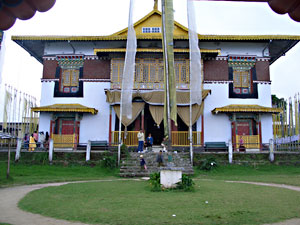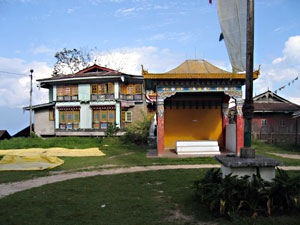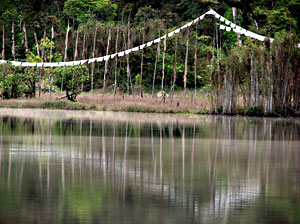|
|
|
Pemayangtse, Sikkim |
|
|
|
Information about Pemayangtse |
|
Pemayangtse or Pelling is situated in West Sikkim at
Gyalshing, about 140 kms. from Gangtok at an altitude of
2085 meters. Pemayangtse literally means the "Perfect
Sublime Lotus" and was built during the reign of the
third Chogyal Chador Namgyal in 1705. Pemayangtse is the
Sikkim’s second oldest monastery, situated near the
start of the Dzongri trek. There are beautiful views of
Kanchendzonga range from Pemayangtse. Pelling or
Pemayangtse is nominally divided into Upper, Middle and
Lower areas, though these effectively merge. A focal
point of Upper Pelling is a small roundabout where the
main road from Geyzing turns 180 degrees in front of
Hotel Garuda. At the same point, minor roads branch
south |
 |
|
|
to Dentem and
southwest to the helipad. It’s not so much a town as a 2 km
string of tourist hotels. Despite of tourists, locals remain
surprisingly unjaded, and the best budget hotels are great for
meeting fellow travelers. Don’s miss strolling up to the
helipad for even more panoramic views.
Tourist Attractions in Pemayangtse
The various tourist attractions in Pemayangtse are Pemayangtse
Gompa, Sangachoeling Gompa, Rabdanste Palace Ruins and
Khecheoparli Lake. |
|
|
|
Pemayangtse Gompa
Pemayangtse Gompa is situated at an altitude of 2105 meters.
Pemayangtse literally means ‘Perfect Sublime Lotus’, and is
one of Sikkim’s oldest and most significant Nyingmapa gompas.
It is magnificently set on a hilltop overlooking the Rabdentse
ruins, and the atmospheric compound is ringed by gardens and
traditional monks cottages walled in unpainted stone. It was
originally a small Lhekhang build by Lhatsun Chenpo in the
17th century. Later during the rule of the third Chogyal
Chakdor Namgyal, Lhatsun Chenpo's third reincarnate jigme Pawo
extended it and rebuild the structure. This monastery belongs
to the Nyigma order and all other Nyigma order monasteries in
Sikkim are subordinate to it. The monastery houses numerous
religious idols and other objects of worship, most of which
are precious because of their antiquity. The contrastingly
colourful prayer hall is beautifully proportioned, its doors
and windows are painted with Tibetan motifs. Its interior has
been renovated many times, the most recent incarnation
featuring murals, including multiple images of Guru
Padmasambhava’s three-head form. |
|
Upstairs, fierce-looking statues depict all eight of
Padmasambhava’s incarnations. On the top floor, Zandog
Palri is an astounding seven-tiered model of
Padmasambhava’s heavenly abode, hand made over five
laborious years by a single dedicated lama, the late
Dungzin Rimpoche. The walls and ceilings have
innumerable paintings and there is an exceptional
collection of religious artworks, including an exquisite
wooden sculpture depicting the resting place of Guru
Rimpoche. There are approximately 100 monks in residence
and according to tradition they have been recruited from
the leading Bhutia families in Sikkim as this is the
‘headquarters’ of the Nyingama sect. The main festival
of the monastery is held on the 28th and 29th day of the
12th month of the Tibetan |
 |
|
|
calendar,
normally corresponding to the month of February. During these
two days religious dances are performed and pilgrims come from
all over Sikkim to watch them.
Sangachoeling Gompa
The second oldest gompa in Sikkim, Sangachoeling has some
beautiful murals and a magnificent ridge top setting. It’s a
steep 3 km walk from Pelling starting along the track that
veers left where the asphalted road rises to Pelling’s new
helipad. A jungle trek continues 10km beyond San-gachoeling to
Rani Dhunga (Queen’s Rock), supposedly the scene of an epic
Ramayana battle between Rama and 10 headed demon king Ravana.
Rabdanste Palace Ruins
Rabdanste is located about 1 km. away from the Gyalshing
bazaar and near the Pemayangtse Monastery. Rabdanste was the
second capital of Sikkim and was established in the late
seventeenth century by the second Chogyal. It was the royal
capital of Sikkim from 1670 to 1814 and was abandoned towards
the end of the eighteenth century because of the threat posed
by the Nepalis and the capital was shifted to Tumlong. The
Rabdanste Palace is now in ruins but the chortens found around
the palace are not in ruins. The entrance to the site is
around 3 km from Upper Pelling, 1 km closer to Geyzing than
the Pemayangtse turn-off. From the site’s ornate yellow
gateway, the ruins are a further 15 minutes’ hike around a
pond then across a forested hill. To reach the palace one has
to trek for about two kilometers from the main road near
Pemayangtse Monastery through a thick forest. The ruins are
being preserved by the Archaeological survey of India and have
been declared as a monuments. Rabdanste consists of chunky
wall-stubs with a few inscription stones. A small
almost-finished museum building should eventually house local
archaeological finds. Daily buses are available form Gangtok
to Gyalsing. |
|
|
|
Khecheoparli Lake
Khecheoparli is pronounced as ‘catch-a-perry’. This holy
lake is highly revered by Sikkimese Buddhists. This lake
is situated at an altitude of 1951 meters on a
bifurcation on the road between Gyalshing and Yoksum.
Kechopari means the Wishing Lake. The water in this lake
is very calm and crystal clear. Not even a leaf can be
seen floating on the water although a beautiful dense
forest lies above the lake. It is said that if a leaf
even drops on the surface of the water it is picked by a
bird. During Khecheodpalri Mela held in March or April,
butter lamps rather than leaves are floated out across
the lake. Prayer wheels line the lake’s jetty, which is
backed by fluttering prayer flags |
 |
|
|
and Tibetan
inscriptions, but the setting, ringed with forested hill,
isn’t really dramatic. To sense its reputed serenity you could
try staying overnight and visiting once the constant trail of
tourists has petered out.
Darap
For a relaxing day trip from Pelling, walk down to gently
pleasant Darap village using the web of village footpaths
through small rural hamlets. Khangchendzonga should be visible
to your right most of the way, at least if clouds are
magnanimous.
How to reach Pemayangtse
By Air:
The nearest airport is situated at Bagdogra, and has daily
Indian Airlines connections with Kolkata and Delhi.
By Rail:
The nearest railway stations are at Siliguri and New
Jalpaiguri which are well connected with other centers in
North and East India.
By Road:
Pemayangtse has only a road connection with the rest of India.
|
|